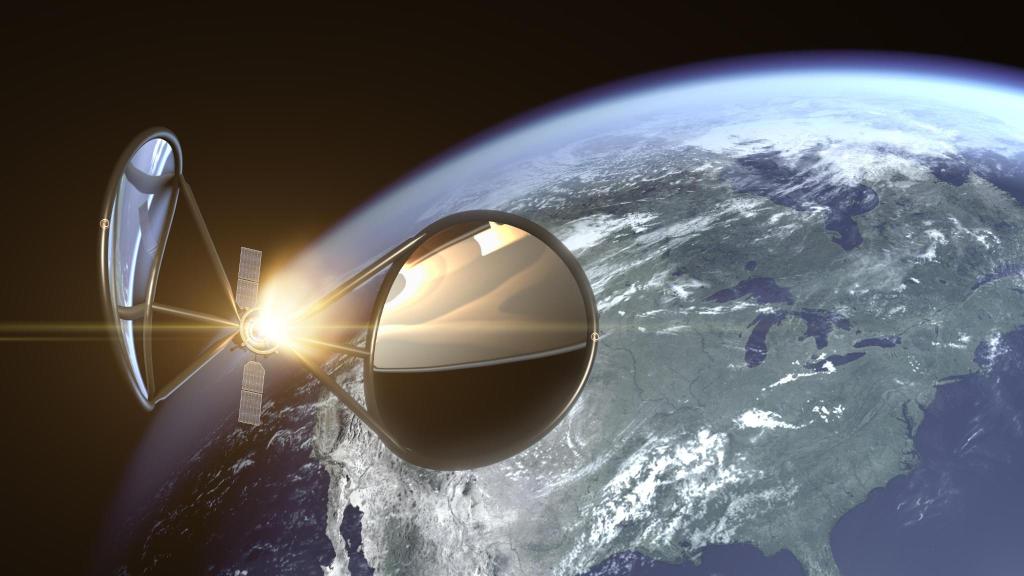Portal Space Systems unveils Supernova, an ultra-mobile spacecraft

The era of stationary spacecraft may soon be over.
Portal Space Systems, a company headed by propulsion expert Jeff Thornburg, is looking to help usher in a new renaissance in in-space transportation with its ultra-mobile Supernova satellite bus. Think of it as maneuverability-as-a-service — tech that could propel transfers from low Earth orbit to geostationary orbit in a matter of hours.
The 500-kg Supernova is designed to be payload agnostic and survive on orbit for at least five years while being continuously maneuvered, the company said. It’s a far cry from legacy spacecraft, which are built to carry only as much propulsion as will be needed to maintain their orbit. Portal’s designed a novel propulsion system, called solar-thermal propulsion, that will produce a massive delta-V of 6 kilometers per second, to enable rapid transfer to cislunar space, or as maneuverable assets to support national security missions.
Portal was founded by space industry veterans Jeff Thornburg, COO Ian Vorbach and VP of engineering Prashaanth Ravindran. Thornburg’s career reads like a history of the space industry writ large. Spanning nearly 30 years, it includes stints at basically ever major aerospace organization: as a military officer in the Air Force; working on liquid rocket engine tech at Aerojet; five years at SpaceX, where he eventually became the second VP of propulsion engineering; working with storied entrepreneur Paul Allen at Stratolaunch; and as a director at Amazon’s Project Kuiper.
“Then I decided I didn’t really want the big company lifestyle and really wanted to dig in on some problems that were not being addressed by any other business, and so my co-founders and I founded Portal Space Systems in November of 2021,” he said. “It’s the only time I feel like I’ve been able to predict the future, even close.”
Given that he has spent most of his career in launch vehicle development and propulsion, he started thinking about what would come next in the industry after SpaceX cracked the code on affordable, rapid, reliable launch. He noticed other trends, too: With more spacecraft launched to orbit than ever before, on-orbit collisions become more likely. On the defense side, Thornburg also started seeing more of a national security interest in responsive space capabilities and the ability for satellites to maneuver “without regret.”
But satellites aren’t designed for moving around a lot in orbit; in general, they are launched with enough on-board propulsion to keep them in their intended orbit, not to dodge other objects, and certainly not with out delta-V capability to go to higher orbit. Supernova is part of a new generation of spacecraft that are looking to change that.
The company has developed Supernova’s propulsion system in-house. The solar-thermal system leverages legacy tech designed by NASA and the Department of Defense, while innovating specific subsystems to optimize for mission performance. For example, the company is bringing a proprietary heat exchanger to that solar thermal propulsion system to deliver even higher performance over a longer lifespan.
“I think the big forcing function here for commercial is just the proliferation of these LEO constellations that they have to maneuver around, and the forcing function for the DOD is China and the future engagement that people believe we’re going to have with them over Taiwan and other issues. Both of those things have come together at the same time, which has created the opportunity that I was hoping for, but didn’t quite predict it being this significant.”
Portal has raised an undisclosed amount of venture funding from unnamed backers, and the first Supernova development is fully funded, the company said. The team has also won over $3 million across five awards from the Space Force and the DOD, including a direct-to-phase II SBIR that’s focused specifically on developing responsive space operations.
Portal is aiming to conduct an in-flight demonstration in late 2025 or early 2026. But before that mission even launches, Thornburg said the startup is looking to scale its team — which stands at around 25 people, but anticipates will swell to up to 200 in 25 years — and grow manufacturing to support the production of multiple spacecraft per year after that first demonstration.